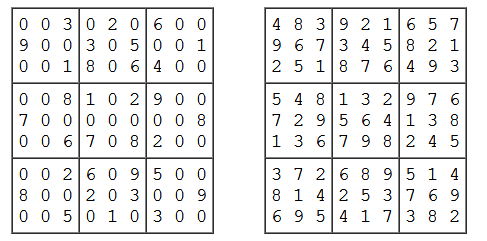Su Doku (Japanese meaning number place) is the name given to a popular puzzle concept. Its origin is unclear, but credit must be attributed to Leonhard Euler who invented a similar, and much more difficult, puzzle idea called Latin Squares. The objective of Su Doku puzzles, however, is to replace the blanks (or zeros) in a 9 by 9 grid in such that each row, column, and 3 by 3 box contains each of the digits 1 to 9. Below is an example of a typical starting puzzle grid and its solution grid.

A well constructed Su Doku puzzle has a unique solution and can be solved by logic, although it may be necessary to employ “guess and test” methods in order to eliminate options (there is much contested opinion over this). The complexity of the search determines the difficulty of the puzzle; the example above is consideredeasy because it can be solved by straight forward direct deduction.
The 6K text file, sudoku.txt(right click and ‘Save Link/Target As…’), contains fifty different Su Doku puzzles ranging in difficulty, but all with unique solutions (the first puzzle in the file is the example above).
By solving all fifty puzzles find the sum of the 3-digit numbers found in the top left corner of each solution grid; for example, 483 is the 3-digit number found in the top left corner of the solution grid above.
数独(日语原意为数的位置)是一种热门的谜题。它的起源已不可考,但是与欧拉发明的一种类似而更加困难的谜题拉丁方阵之间有着千丝万缕的联系。数独的目标是替换掉9乘9网格中的空白位置(或0),使得每行、每列以及每个九宫格中恰好都包含数字1~9。如下是一个典型的数独谜题以及它的解答。

在这个6K的文本文件sudoku.txt(右击并选择“目标另存为……”)中包含有50个不同难度的数独谜题,但保证它们都只有唯一解(文件中的第一个谜题就是上述样例)。一个构造精良的数独谜题应该包含有唯一解,且能够通过逻辑推断来解决,尽管有时可能必须通过“猜测并检验”来排除一些选项(这一要求目前还颇受争议)。寻找答案的复杂度决定了题目的难度;上面这个谜题被认为是简单的谜题,因为我们可以通过直截了当的演绎推理来解决它。
解开这50个谜题,找出每个谜题解答左上角的三个数字并连接起来,给出这些数的和;举例来说,上述样例解答左上角的三个数字连接起来构成的数是483。
解题
读取数据,求解数独。
1.读数据,用Java还是比较简单的,但是最后一个数独我还是忘了,这个是由于在加入数独的时候判断条件的问题最好一个要单独加入。详细看程序
2.求解数独
数独的特点:1.每行数字只能是1到9且不能重复。2.每列数字只能是1到9且不能重复。3.数字所在的行和列只能是1到9且不能重复。
之前做过一个验证有效数独,好像可以直接拿来用,那么,怎么用?
对于没有填取数字的数独,暴露变量1-9,然后判断是否是合法的数独,然后再暴露填充下一个空的数并判断合法性。用于DFS的思想。
JAVA
package Level3; import java.io.BufferedReader; import java.io.FileReader; import java.io.IOException; import java.util.ArrayList; public class PE096{ public static void run() throws IOException{ ArrayList<int[][]> sudoku= getSudoku(); int[][] sd = sudoku.get(0); int result = 0; for(int index=0;index<sudoku.size();index++){ sd = sudoku.get(index); solvesudoku(sd,0); result += sd[0][0]*100+sd[0][1]*10+sd[0][2]; } System.out.println(result); } // 24702 // running time=0s515ms public static boolean solvesudoku(int[][] sd,int index){ if(index >= 81) return true; int x = index/9; int y = index%9; if(sd[x][y]==0){ for(int n=1;n<=9;n++){ sd[x][y] = n; if(CheckrowAndcol(sd,x,y,n) && CheckGrid(sd,x,y,n)) if(solvesudoku(sd,index+1)) return true; sd[x][y] = 0; } }else return solvesudoku(sd,index+1); return false; } // 判断 n 所在的行列是否包含 n public static boolean CheckrowAndcol(int[][] sd,int x ,int y,int n){ // x 行 for(int j=0;j<9;j++){ if(j!=y && sd[x][j] ==n ) return false; } // y列 for(int i=0;i<9;i++){ if(i!=x && sd[i][y]==n ) return false; } return true; } // 判断所在的方格是否包含 n public static boolean CheckGrid(int[][] sd,int x,int y,int n){ // 根据x y的坐标求其所在方格的左上坐标和右下坐标表示不好想。 for(int i = (x/3)*3;i<(x/3+1)*3;i++){ for(int j=(y/3)*3;j<(y/3+1)*3;j++){ if(i!=x && j!=y && sd[i][j]==n) return false; } } return true; } public static ArrayList<int[][]> getSudoku() throws IOException{ ArrayList<int[][]> sudoku= new ArrayList<int[][]>(); int[][] sd = new int[9][9]; String filename = "src/Level3/p096_sudoku.txt"; BufferedReader data = new BufferedReader(new FileReader(filename)); String tmp = null; // 第几个数独 int index = 0; // 读取到数独的某行 int row = 0; while((tmp=data.readLine())!=null){ String grid=tmp.substring(0,4); if(grid.equals("Grid")){ if(index!=0){ sudoku.add(sd); } index++; row =0; sd = new int[9][9]; }else{ String[] arrayStr = tmp.trim().split(""); for(int i=0;i<9;i++){ sd[row][i] = Integer.parseInt(arrayStr[i+1]); } row++; } } //最后一个数独 sudoku.add(sd); return sudoku; } public static void main(String[] args) throws IOException { long t0 = System.currentTimeMillis(); run(); long t1 = System.currentTimeMillis(); long t = t1 - t0; System.out.println("running time="+t/1000+"s"+t%1000+"ms"); } }
论坛中直接复制的Python程序
# coding=gbk import copy import time as time filePath = 'E:/java/projecteuler/src/Level3/p096_sudoku.txt' dim = 9 # 判断数独的合法性 def assert_sudoku(puzzle): # 行列 for i in range(dim): seen_row = [] seen_col = [] for j in range(dim): if (puzzle[i][j] and puzzle[i][j] in seen_row) or(puzzle[j][i] and puzzle[j][i] in seen_col): return False seen_row.append(puzzle[i][j]) seen_col.append(puzzle[j][i]) # 方格 for boxIDX in range(3): for boxIDY in range(3): seen = [] for boxX in range(3): for boxY in range(3): value = puzzle[3*boxIDX + boxX][3*boxIDY + boxY] if value and value in seen: return False seen.append(value) return True def find_empty_cell(puzzle): empty_cells_col = [0]*dim empty_cells_row = [0]*dim for i in range(dim): for j in range(dim): if puzzle[i][j] == 0: empty_cells_col[i] +=1 if puzzle[j][i] == 0: empty_cells_row[i] +=1 empty_cells = [] for i in range(dim): for j in range(dim): if puzzle[i][j] ==0: empty_cells.append([[i,j],min(empty_cells_row[j],empty_cells_col[i])]) if len(empty_cells) == 0: return [] best_empty_cell = min(empty_cells, key=lambda x: x[1]) return best_empty_cell[0] def solve(puzzle): empty_cell = find_empty_cell(puzzle) if len(empty_cell) == 0: return puzzle for value in range(1, dim+1, 1): new_puzzle = copy.deepcopy(puzzle) new_puzzle[empty_cell[0]][empty_cell[1]] = value if not assert_sudoku(new_puzzle): continue new_puzzle = solve(new_puzzle) if len(new_puzzle) == 0: continue else: return new_puzzle return [] def main(): file = open(filePath, "r") data = file.readlines() data = [row.strip() for row in data] row_id = 0 puzzle_id = 0 result = 0 while row_id < len(data): assert(data[row_id] == "Grid {:0>2d}".format(puzzle_id + 1)) # print(time.strftime("%H:%M:%S ") + data[row_id]) row_id += 1 puzzle = [] for puzzle_row_id in range(dim): puzzle.append([]) for col_id in range(dim): puzzle[-1].append(int(data[row_id+puzzle_row_id][col_id])) puzzle = solve(puzzle) result += int("{}{}{}".format(*puzzle[0])) row_id += dim puzzle_id += 1 print(result) t0 = time.time() main() t1 = time.time() print "running time=",(t1-t0),"s" # 24702 # running time= 117.409999847 s